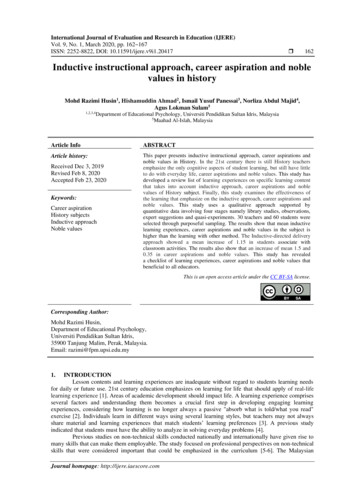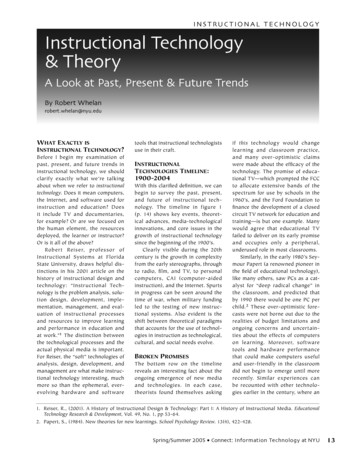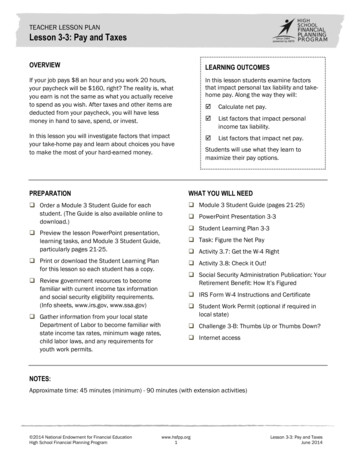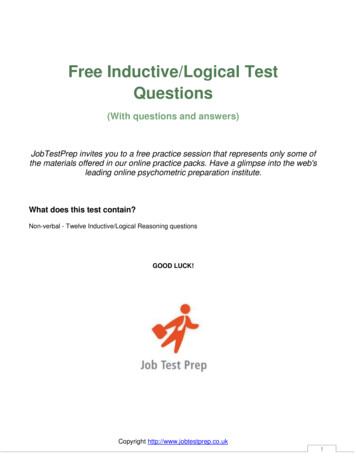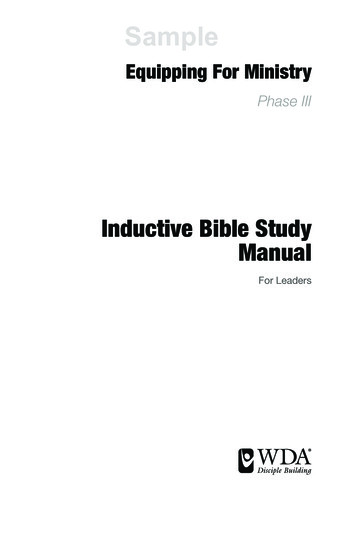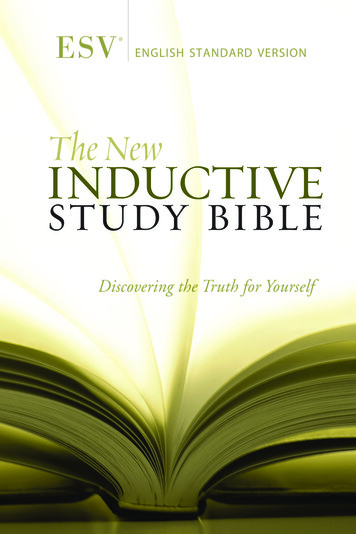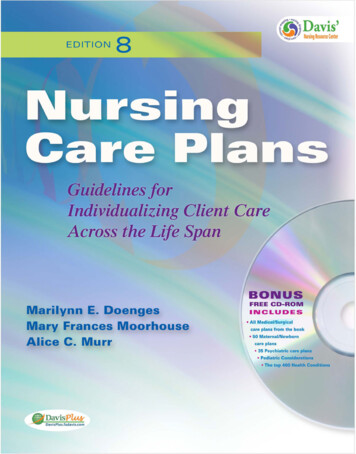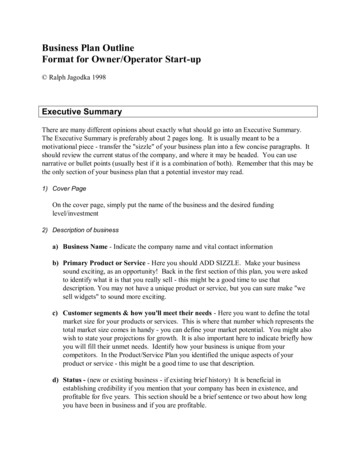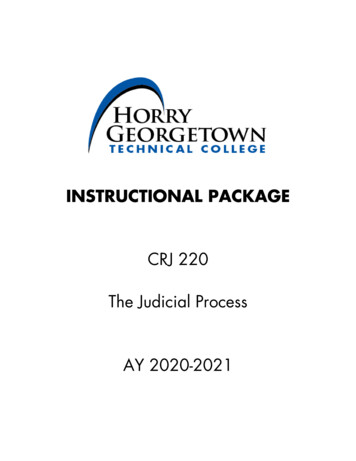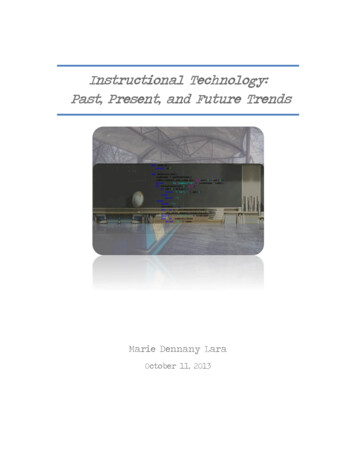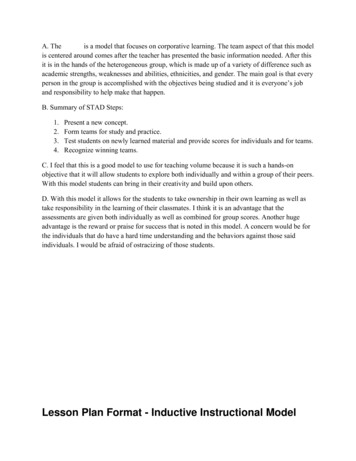
Transcription
A. Theis a model that focuses on corporative learning. The team aspect of that this modelis centered around comes after the teacher has presented the basic information needed. After thisit is in the hands of the heterogeneous group, which is made up of a variety of difference such asacademic strengths, weaknesses and abilities, ethnicities, and gender. The main goal is that everyperson in the group is accomplished with the objectives being studied and it is everyone’s joband responsibility to help make that happen.B. Summary of STAD Steps:1.2.3.4.Present a new concept.Form teams for study and practice.Test students on newly learned material and provide scores for individuals and for teams.Recognize winning teams.C. I feel that this is a good model to use for teaching volume because it is such a hands-onobjective that it will allow students to explore both individually and within a group of their peers.With this model students can bring in their creativity and build upon others.D. With this model it allows for the students to take ownership in their own learning as well astake responsibility in the learning of their classmates. I think it is an advantage that theassessments are given both individually as well as combined for group scores. Another hugeadvantage is the reward or praise for success that is noted in this model. A concern would be forthe individuals that do have a hard time understanding and the behaviors against those saidindividuals. I would be afraid of ostracizing of those students.Lesson Plan Format - Inductive Instructional Model
Teacher Name: Stephanie Workman Subject: MathTitle of Lesson: 3-D RobotsGrade: 5thTime Needed: 60 minutesInductive Instructional Model The Student Teams –Achievement (STAD) ModelI. Rationale: Students will develop a deeper conceptual understanding of thevolume of rectangular prisms while making the connection to the formula : LWHII.Learning Prerequisites: III.Students should be able to accurately calculate basic multiplicationproblemsStudents should be able to accurately identify the perimeter of a shapeStudents should have a good understanding of how to calculate areaStudents should be able to identify the different attributes to a 3dimensional shape (Length, Height, Width)Students should be able to identify different 3-Dimensional figures such ascubes and rectangular prisms.Goals and Student Objectives:III a. Goals: Students will measure the volume of rectangular prisms by packing themwith cubic units.Students will compare and contrast area and volume in speaking andwriting terms.III b. Student Objectives: IV.I can measure volume by counting by different size unit cubes.I can identify if a figures volume changes based on the measurementmaterial.I can create a 3 Dimensional figure with a given volumeI can calculate a solid figures shape if I am given its length, width, andheight.I can work cooperatively with a group to develop a solution to a problem.Organizing or Essential Questions:
V.What is volume?How are area and volume alike and different?How do you measure volume?Does volume change when you change the measurement material? Why orwhy not?How can you find the volume of cubes and rectangular prisms?Lesson Procedure:A. Lesson Introduction:1. To begin the lesson I will have a box wrapped in birthday paper filled withwrapped cubes pieces of caramels.2. I will ask for students to take a guess as to how many wrapped caramels Ihave in my box. Each group is allowed to ask one question.3. Each individual would have to write a number down along with adescription as to how they arrived at that number and how, if at all, thequestions asked helped in determining their number. Students should alsowrite down any questions they had that were not asked. (WritingComponent)4. I would then explain to the students that the group that had the highestcombined scores combined with a 50 point bonus if any group guessedcorrectly could have the caramels that were in the box.5. Then you would go over the objectives for the lesson.B. Lesson Development:1. To begin with I would present the class with a power-point that sharesbasic information in regards to the vocabulary that the students need tohave. The following terms would be defined: Volume Area Cubic Unit Perimeter2. Explain to the students that they have 45 minutes to develop a plan ofaction and implement it in order to answer the essential questions.3. Explain to the students that the essential questions that we are working onwith this lesson are the goal questions that will need to be answered byeach group at the end of the period with examples to support theiranswers. The delivery of these answers will be up to the groups themselvesbut I would request creativity and not just lecture. (This would be achange to the model only because I know my students and ifallowed everyone would stand up answer the questions and sitdown. I want to see more ingenuity and hands-on explorationwith this lesson)
4. Model what it looks like to be an active and cooperative member of agroup and go over the different norms that occur in a successfulcollaborative setting: (This list of norms is created by the class previously) We listen to one another. We share our own ideas and explain them. We respect one another’s ideas, even if they are different. We respectfully disagree and try to see the other view. We let others finish explaining their ideas without interrupting. We take turns and share time. We help take responsibility for not just our own but everyone’slearning(Steps 1-4 of the lesson targets Step 1 of the STAD model where theteacher presents the basic information that the students need toknow to expand on a skill, concept or objective)5. After going over the needed information I would assign groups. The groups will be determined in a heterogeneous manner basedon the following criteriao Academic levelso Gendero Learning styleso Social characteristics6. Next I would allow the students 45 minutes to work together to come upwith a solution to the questions and a mode to deliver their findings. Students will be permitted to use any manipulatives or suppliesneeded in the class room to complete this tasko Some of those supplies include but are not limited to:o Different size cubeso Geometrical netso Technology such as smart board programs While the students are working I will simply be walking around theroom monitoring and assessing how they are progressing andcollaborating.7. Finally when time is up, students would report out to the class what theydiscovered in regards to the questions from the beginning of the lesson. They would also have to support their answers by giving concreteexamples that they had discovered along the way. After each group has shared the floor will be open to question anddiscussion.o Prompt students to ask those higher level questions of whyand how come with expectations of deeper level thinking andresponses. (Steps 5-7 of the lesson fall under Step 2 of the STAD modelwhere teams are chosen. The model shows that studentscould pick these teams but in my experience they would not
diversify enough to make it a true heterogeneous group.)Thisstep also encompasses student experimentation and practice.In this step students come up with solutions to problems ontheir own through peer collaboration and their on vices. It isthe responsibility of everyone in the group to make sureeveryone is understanding and competent in the skills andobjectives that they are working on. )C. Guided or Independent Practice:1. To practice students newly acquired skills, we would play a quiz Kahoot. In this game it will be played individually so I can score individualsas well as a combined team score. The quiz is created by me and involves questions that will assesstheir understanding of the objective (volume) This game will contain not just worded questions but visual ones aswell that will be projected through the Smartboard.o Examples of questions:o How are area and volume similar? Different?o What is the volume of this cube if those are1cm cubes?o If you have a rectangular prism with the dimensions : height3”, width 4” length 2 “ how many 1 inch cubes would youneed to fill it up?Each student will have their own device (either their phone or aclass iPad.) They will use these devices to select their answers andkeep track of their individual scores by logging onto the Kahoot siteand signing in under specified quiz name.(Technology Component)2. . When the quiz is over I would print out the student’s scores to be addedtogether by team at the end of the lesson.D. Lesson Closure:1. To close out the lesson I would refer back to the wrapped box containingcaramels. I would give the groups a second chance to make a guess atthe amount of caramels in the box.
This time each group could ask 1more question in regards to the box orthe caramels. When they asked a question they would have to explain thereasoning behind their question.3. After all groups have wrote down their answer to how many cubes ofcaramel is in the box, as a class we would open the box and count theamount of cubes.4. After tallying all of the scores (including any bonus points for the caramelactivity) I would award the winning team with the prize. (This is the finalstep in the STAD Model- Recognize the winning team)2.E. Homework:1. For the students homework they would be assigned to measure the size oftheir bedroom at home.2. They should then draw a replica of their room correctly labeling theappropriate dimensions.3. They must then calculate what the volume is in terms of cubic inches,cubic feet and cubic yards.4. They should then answer the following question: Did the volume of yourroom change when the size you used to calculate changed? Why or whynot?VI.Formative Student Assessment and Evaluation:1. The first formative assessment that I would use is anecdotal notes.a. These notes would happen throughout the lesson but especially asI am walking around and observing during group time.b. Some things I would be looking for is cooperation within the group,discussions that would show understanding or a lack ofunderstanding of old concepts or new concepts, areas that willneed reinforced or prompted at a later time.VII.Materials and Resources:ooooooooWrapped box filled with cubed caramelsA variety of sizes in cubesRulers, meter sticks, yard sticks, tape measureGeometrical netsGraph paperPencils colored pencilsStudent devicesSmartboard
VIII. Modifications for Diverse Learners: In this STAD model it lends way todiversity. In fact it embraces it with its second step of creating heterogeneous groups.Through the diversity is where the different learning style and idea have the opportunityto come from. Some modifications that I would use however would be:o allowing students peer help during their presentationso guided questions that would help guide their explorationo To challenge those that are gifted in their home work they would needto find the volume of their entire home.IX. Reflection/Modification:To evaluate I would create a list of questions that I would ask my co-teacher to answeras she observed the lesson. Some of the questions would be: Were my students engaged from start to finish?o If not when/what was happening when that disengagement occurred?o If so what parts had the most engagement? Was my lesson to hard or easy? Was my information clear and concise? What were my strengths and weaknesses? How was my time management? (Something I often struggle with) How can I improve this lesson?At the end of the lesson and after she had a chance complete the questions we wouldsit down and discuss the lesson and what she observed.
V. Lesson Procedure: A. Lesson Introduction: 1. To begin the lesson I will have a box wrapped in birthday paper filled with wrapped cubes pieces of caramels. 2. I will ask for students to take a guess as to how many wrapped caramels I have in my box. Each group is allowed to ask one question. 3.
